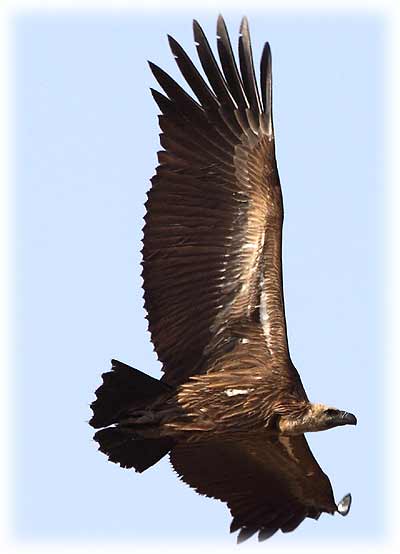 An account of Namibia's Seven Recorded Vulture Species in celebration
of International Vulture awareness Day on 03/09/2011
An account of Namibia's Seven Recorded Vulture Species in celebration
of International Vulture awareness Day on 03/09/2011
[New
Era – 1 September 2011]
African
White-backed Vulture: About 85 cm tall with a wingspan of 212
to 218 cm and a weight of 2 to 5 kg.
The most common vulture in Namibia also found throughout sub-Saharan
Africa. They prefer flat open savannah with scattered large trees
for roosting and nesting. Roosts on open perches but is more commonly
seen circling in or gliding toward thermals high overhead.
Conservation Status: Threatened
Cape Vulture:
About 95 cm tall with a wingspan of 255 cm and a weight of 7.5 to
9.5 kg.
This southern Africa endemic is a cliff-nester. The world population
is only about 2000 birds. Adult birds, in the non-breeding season,
and immature birds may wander over 1000 km from the cliff sites.
Conservation status: Threatened globally Extinct in Swaziland Critically
Endangered in Namibia
White-headed
Vulture: About 75 cm tall with a wingspan of 230 cm and a weight
of 3.8 kg to 4.7 kg.
In Namibia this bird can be seen in the north and north east. They
occur from the Red Sea through sub-saharan Africa to southern Africa,
which has about 7% of the world population. They are often first
at a carcass but usually only one bird or a pair of birds are seen.
The pairs mate for life.
Conservation status: Vulnerable and at risk
Lappet-faced
Vulture: About 100 cm tall with a wingspan of 258 to 280 cm
and a weight of 6.5 kg.
This bird only has a world population of about 8500. They are found
through the Arabian Peninsula and sub-saharan Africa and use open
woodland and semi-arid to arid habitat. In Namibia, about 50 pairs
breed in the Namib Desert. Their size allows them to dominate the
feeding at a carcase.
Conservation status: Vulnerable and threatened
Hooded Vulture:
About 60 cm tall with a wingspan of 170 to 176 cm and a weight of
2 to 5 kg.
Although most common in eastern, western and north-eastern Africa
they can be seen in north-eastern wooded areas of Namibia. Besides
carrion, they also eat small scraps and pick at dung to find insects.
Conservation status: Vulnerable in southern Africa
Egyptian
Vulture: About 50 cm tall with a wingspan of 155 to 170 cm and
a weight of 2 to 5 kg.
This cliff roosting and nesting vulture feeds on carrion and walks
about searching for insects and other birds' eggs. They have mastered
the art of opening eggs by throwing rocks at them.
Conservation status: Extinct as a breeding species in southern Africa
and threatened elsewhere.
Palm-nut
Vulture: About 55 cm tall with a wingspan of 150 cm and a weight
of 2 to 5 kg.
This vulture's diet is mainly the fruit of palm trees and some small
carrion. They are dependant on the conservation of rivers and riverine
forests and in Namibia may only be seen along the northern rivers
roosting in large trees or wandering along the river banks.
 Liz
Komen Liz
Komen
NARREC
|
 Liz
Komen
Liz
Komen